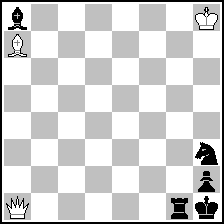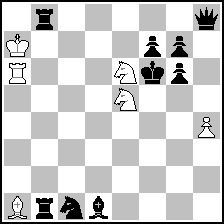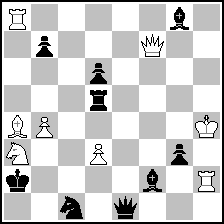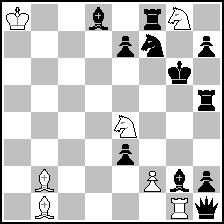|
| Page: [Previous] [Next] 1 2 3 |
| (1) Posted by seetharaman kalyan [Thursday, Mar 22, 2012 14:38]; edited by seetharaman kalyan [12-03-23] |
Goethart unpin - Can it be shown in helpmates?
I came across this fine problem by Jean Hayman, First prize, Israel Ring Tourney, 1983. It is from the excellently produced (recently published) book "Israeli Chess Problem Art". The theme indicated was "Goethart" (unpin ?). Enjoy the nice anticipatory shut off (by white) of the pinned black rook, moving on the pinline behind the white men, so that it can be unpinned harmlessly.
But, look more closely ! What is the white rook at h3 doing ! Remove it, the problem is still sound !!
I wonder if this theme can be satisfactorily shown in helpmates. Perhaps it is suited only for the directmates (and selfmates perhaps).
 (= 11+8 ) (= 11+8 )
h#2 (2111)
|
|
| (2) Posted by Nikola Predrag [Thursday, Mar 22, 2012 16:43]; edited by Nikola Predrag [12-03-22] |
Wow, quite an offending mockery with wRh3.
We can all make jokes with the definition of some theme. But some elements of the following example may be useful for the helpmate Goethart:
 (= 3+5 ) (= 3+5 )
h#1,5; 0.5.1.1.
Without wKh8 there is 6th solution
|
|
| (3) Posted by Jacques Rotenberg [Friday, Mar 23, 2012 04:18] |
@ Seetharaman :
Once again a good example of the limits of "hunting weasels".
@ Nikola :
It seems that "Goethart theme" needs battery mates
|
|
| (4) Posted by seetharaman kalyan [Friday, Mar 23, 2012 13:40]; edited by seetharaman kalyan [12-03-23] |
Without battery mates, the theme is "Gamage unpins". The sixth solution (with WKh7 perhaps) is very interesting !
|
|
| (5) Posted by Nikola Predrag [Friday, Mar 23, 2012 16:41] |
Well, I apologize if my joke was too rude. Many thanks to the authors of TnT, a great enterprise. But there's a missprint or someone should better clarify to me a difference between Goethart and Gamage. Copy-paste from TnT:
White closes the line of black's pinned piece allowing white to unpin it directly on the mating move. [kv]
Note: Like bicolor Gamage where the unpin is direct. [kv]
I don't know the author's full solution but it obviously contains tries or antidual play:
1.Bg2 d4? 2.Rf3 Se3+? 3.Rf7!; 1.Rh1 Rf4? 2.Rd3 Sc3+? 3.Rd5!
Tries fail because of the unpin so the play in the solution must enable bRg3 to hide behind wPd4/wRf4. These tries suggest that Goethart theme will be present in solutions. But it is simply not present, wRh3 is not even a vague weasel, it is just superflouos. It should be needed at least in one phase to become a disputable weasel.
|
|
| (6) Posted by Administrator [Friday, Mar 23, 2012 19:37] |
TnT is still in an unofficial (work-version) state, so some definitions found there should not be taken for granted!
|
|
| (7) Posted by Michael McDowell [Friday, Mar 23, 2012 21:03] |
Two examples:
A.Uddgren
1Pr Tanacsa JT 1966
 (= 6+9 ) (= 6+9 )
Helpmate in 2 (2 solutions)
1.R1b6 Sxg7 2.Bb3 Sc6
1.R8b2 Sxg6 2.Sb3 Sd4
J.Korponai
1Pr Dunaujvarosi TS 1970
 (= 8+9 ) (= 8+9 )
Helpmate in 2 (2 solutions)
1.b6 Bc2 2.Bc5 Sc4
1.b5 Sc4 2.Rc5 Bc2
|
|
| (8) Posted by Nikola Predrag [Friday, Mar 23, 2012 22:48] |
First example is beautiful. R1b6/R8b2 look like anticipatory selfpins but actually they only alow Se6/Se5 to move without check. So, Ra6/Ba1 are highly thematic pieces even in the phase where they are superfluous in the end.
Second one is also beautiful but Qf7&Rh2 are supefluous in the end of both solutions. But they are thematic in both phases, determining the moves order. There are cooks in given position, +wPf6 may prevent them.
A diagram with clumsy example of ser-h#3 with thematic mate-tries would not be proper after these beauties. For the ever curious, here's the notation with solutions: 6s1/b3pP1b/3p1P2/1ppkr2R/3rp1s1/KPP2S2/6B1/1q1R4; ser-h#3; b)rot. 90 clokwise
a) 1.e3 2.Bc2 3.Rd3 Sd4#(Sg5+? 4.Re4!); b)1.d3 2.Qf2 3.Re3 Se4#(Sb5+? 4.Rd4!)
|
|
| (9) Posted by Michael McDowell [Friday, Mar 23, 2012 23:09] |
Sorry Nikola - carelessness on my part. There is a white pawn on f6.
Another beautiful problem with a slight twist on the theme is the following:
Harry Fougiaxis
1Pr Sinfonie Scacchistiche 1984
 (= 8+12 ) (= 8+12 )
Helpmate in 2 (2 solutions)
1.Rf7 Rb3 2.Sd7 Sdf4
1.Bb3 Rf7 2.Sc4 Sdc3
|
|
| (10) Posted by Jacques Rotenberg [Sunday, Mar 25, 2012 01:28] |
@ Nikola,
"...Tries fail because of the unpin so the play in the solution must enable bRg3 to hide behind wPd4/wRf4. These tries suggest that Goethart theme will be present in solutions. But it is simply not present, wRh3 is not even a vague weasel, it is just superflouos. It should be needed at least in one phase to become a disputable weasel."
To say it quickly this problem (of Jean Haymann) is one of my favourites.
The fact that the solution "is unchanged" if you remove the wRh3 ? I don't care !
The Rh3 is certainly not superfluous.
|
|
| (11) Posted by Nikola Predrag [Sunday, Mar 25, 2012 06:38]; edited by Nikola Predrag [12-03-25] |
@Jacques
"The Rh3 is certainly not superfluous."
OK, I surely miss something important in the content. So far I see: it looks nice to me without Rh3, and with this Rook there's nothing less, nothing more in the content. The tries show the impotence of wR and the solutions do not empower it 'surprisingly' but only prove it is useless and useless in all aspects.
Prehaps the idea was to show something that is NOT Goethart unpin although it fits into the definition/description. A definition does not make a theme. Reasons and motivations do. They make the essence and original presentation of any theme.
Placing wBa1,wRb1 and playing Bb2/Rb2 does not make the batteries nor the Grimshaw, everybody knows that, at least I hope. Reasons and motivations would make these themes.
In some #2, a black piece plays behind w/b piece with some reason, certainly OTHER than hiding but White uses that hiding effect for a new mate. Haymann's bRg3 plays to f3/d3 WITH the reason to hide behind the white pieces, EXACTLY BECAUSE it will be unpinned in the end. Since in the end there's no pin, the initial pin or pinning during the play must be motivated somehow, otherwise the pin itself is supefluous. It seems easier to motivate it during the play as shown by A.Uddgren (check prevention).
A presence of an initial pin seems difficult for justification but a play where one piece will be unpinned so it could close a line of some other piece in one phase, with reciprocity in the other, that looks well motivated. Whether this makes the Goethart unpin or a nameless theme, I don't care, J.Korponai created the purpose for two 'weasels'.
I'll try again to find which motivations Jean Haymann has invented.
|
|
| (12) Posted by Harry Fougiaxis [Sunday, Mar 25, 2012 15:44] |
An early attempt by the great Páros, which suffers from the same flaw is:
György Páros
Hungarian Chess Federation Ty 1965
1st Prize
 (= 7+11 ) (= 7+11 )
h#2 2111
1.Sg5 (Se5?) Bf6 2.Sf3 Sg5#
1.Rh3 (Rf5?) f4 2.Rf3 Sg3#
Chris Feather writes in "György Páros: Ein Begründer des Modernen Hilfsmatts": The spectacular impression won this problem a first prize and a place in the FIDE Album, but to those who look better the concept is flawed. [..] the g-file pin is not logically necessary and the same solutions work if the weasel white rook is removed (and the wBb1 moved to c2).
|
|
| (13) Posted by Hauke Reddmann [Sunday, Mar 25, 2012 17:40] |
The whole problem is well known in the area of white line
combination - any Q/R/B that gets intercepted in the
solution is in danger to be superfluous. If you remove it,
you ruin the theme. Give it protection properties or
side variants (the latter isn't possible in h#), or
encounter the wrath of the experts :-)
Random example:
http://www.bambam42.de/problem/problem2.html, SCHWALBE 8839.
The Bh8 is superfluous.
http://www.bambam42.de/problem/version.html#S8839
Better now :-)
Hauke
|
|
| (14) Posted by Uri Avner [Monday, Mar 26, 2012 02:07] |
It all depends on which glasses you are wearing.
Paros’s as well as Haymann’s, if seen from a mechanical point of view have superfluous wRs, no doubt.
But if you look at them from a non-mechanical perspective, the Rooks are essential in both, if only for the conceptual part of the problem, which for some of us still means something.
Many themes would look silly if the non-mechanical part is abandoned. For a robot, the so called “paradoxes” in problems are all superfluous and a wrong idea invented by human stupidity.
Does our over-occupation with computers makes us more and more look like them?
|
|
| (15) Posted by Nikola Predrag [Monday, Mar 26, 2012 09:35] |
Yes, it's about a robot approach. Recognition of a theme by a mere definition is also a robot way. That's why I want to see some chess reason and motivation. In a pure Bristol, the front piece is superfluous in the end but it makess a move and it is an obstraction which mut be resolved. When a piece has absolutely no purpose, that is a robot way to recognize a paradox through a hollow definition. Of course if humans DO SEE a paradox, I accept this even if I do not see it.
|
|
| (16) Posted by Kostas Prentos [Monday, Mar 26, 2012 19:38] |
Is it my impression or the content in Paros's problem is even improved without the white Rg1? There is some interest if the direct unpins of wSe4 are possible, when Bg2 is given some mobility (if it is not pinned). I fail to see any paradox for the use of the Rook and I tend to believe that its existence was simply an oversight by the composer, or over-cautiousness because the problem was composed before the computer era.
|
|
| (17) Posted by seetharaman kalyan [Monday, Mar 26, 2012 20:52] |
I am sure that Paros too like Hayman wanted to show the attractive and difficult doubling (on the same pinline) of the Goethart unpin. Rg1 cannot be an oversight. It is just the case that in such themes it is very difficult and rare to find use for the blocked white piece. Idle piece or not, these problems are surely excellent and worthy of the expense !
I just wanted to highlight the difficulty of interpreting such Direct mate themes in help-play problems.
|
|
| (18) Posted by Kostas Prentos [Monday, Mar 26, 2012 22:51] |
Thank you, Seetharaman. I am not familiar with uncommon direct-mate themes, but I think I understand now. The idea for the white Rook was the unpin of the black Bishop with white's mating move. Unfortunately, this idea is not convincing, since the black Bishop is neutralized anyway. If I had to choose, I would avoid the expensive use of the Rook for the extra effect, but I am beginning to question the fundamental rules of helpmates.
In any case, my previous post was completely wrong. Paros must have been aware of the Rook issue, but he chose to keep it. Many would do the same, apparently.
|
|
| (19) Posted by Uri Avner [Tuesday, Mar 27, 2012 02:01] |
Without Paros's wRg1 we are talking about a different problem.
Both problems (with and without Rg1) share the same technical solution, but not its meaning.
The understanding of this is a precondition (necessary but not sufficient) for any comparison between them.
|
|
| (20) Posted by Nikola Predrag [Tuesday, Mar 27, 2012 02:10]; edited by Nikola Predrag [12-03-27] |
This topic proves that my beliefs about chess problems are wrong. I believe that Goethart theme would never get this status on the basis of a problem in which a thematic pinning piece has absolutely no function in any phase - if there's only an initial pin, never utilized and this piece never gets any other purpose.
If I imagine some hypothetical paradox and just for ilustration present a rough scheme with artificial presence of a thematic piece, I would expect to hear: "Yes, we now understand the idea but could it be convincingly realized". Then I work hard for days or years and finally make the thematic content convincing, with justified presence of a thematic piece. And the new theme might even get my name.
I believe that when someone later claims that his problem shows 'my theme' with artificial presence of a thematic piece, I have every right to say:"No, it is not my theme, I worked a lot to find a real purpose for the thematic piece, to make a Theme out of a scheme.
I wonder, did the theme get Goethart's name on the basis of a problem with a completely artificial and superfluous presence of a thematic pinning piece? That might help me to reconsider my beliefs.
|
|
Read more... |
Page: [Previous] [Next] 1 2 3
MatPlus.Net  Forum Forum  Helpmates Helpmates  Goethart unpin - Can it be shown in helpmates? Goethart unpin - Can it be shown in helpmates? |
 ISC 2024
ISC 2024 Forum
Forum  Helpmates
Helpmates  Goethart unpin - Can it be shown in helpmates?
Goethart unpin - Can it be shown in helpmates? 


